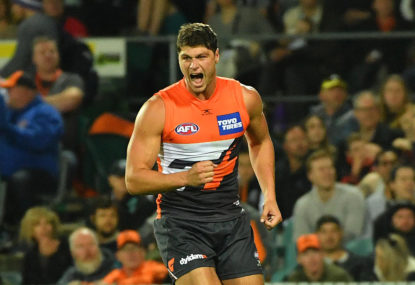The Team Who Shall Not Be Named. No, not the character from that juggernaut literary series and blockbuster movie franchise. Although today we will talk about a juggernaut, and depending on who you ask, an entity some consider just as evil.
The team that awoke around this time last year, hinting at its collective potential. The team that plays with its food.
The team that is full of players that most teams would trade their soul to have just one on their roster. The team that does things with Australian footballs that are difficult to do with regular shaped balls.
The team that started the year with a fixture that felt like a deliberate handicap, placed upon it by a Dr Frankenstein uneasy with the reality of its creation. The team which is stuck on a treadmill of sustained excellence, with an economy geared to allow it to cycle through the top of the draft for a few years yet. The team that if you ask any long-time AFL fan is a team with no fans.
The football embodiment of the evil corporatism of the AFL, a purchase order addressed to the 16 pre-expansion clubs planted in Sydney’s west.
I’m talking of course about the team who sit 4-1 with 139 percentage points. The team whom many expected to run through the season mostly undefeated. The team loaded with blue-chip talent, laden with quality veterans, with a new clutch of youngsters whom they have leant on in the early rounds.
Remember them? After a first round stumble, the Greater Western Sydney Giants have stomped all over their opponents and laid bare their ability to run through the competition from this point on. The Voldemort of Australian football, GWS’ strong start to the year has been swept under the carpet, out of sight and out of mind.
No longer. The Giants make their Friday night football debut this week, hosting a wounded reigning premier yet to rediscover the magic of last year’s finals campaign. GWS’ brilliance – their daring attack on the football, incisive and precise ball movement, and all-day running power – will be on show for the football world to see.
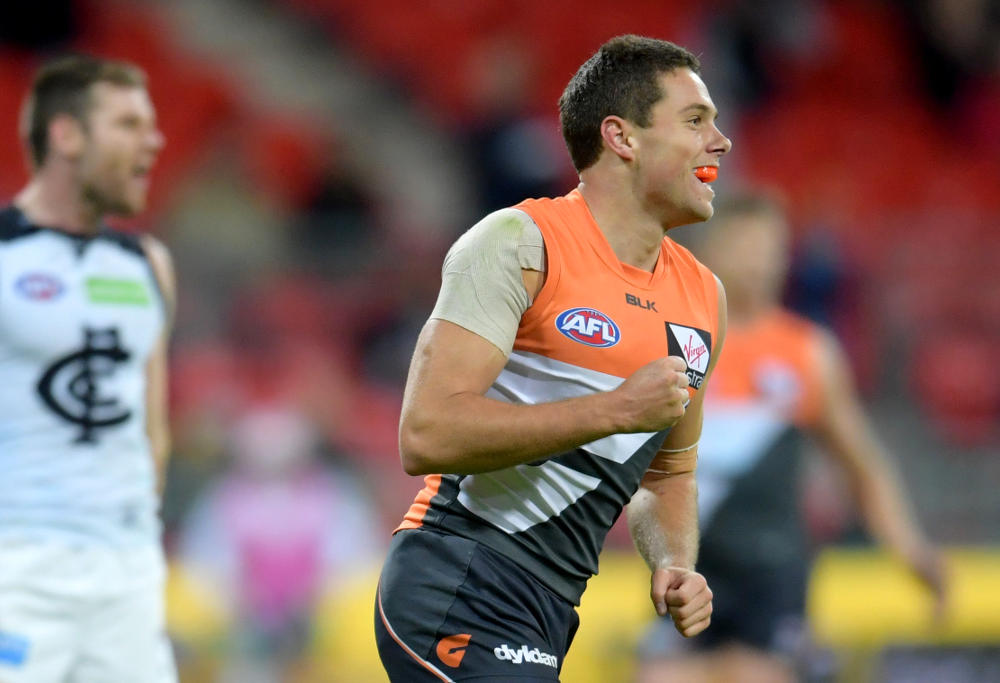
Sydney-side drubbing a measure of the season to date
Greater Western Sydney beat their bigger brother by 42 points on Saturday night. But the margin was really 66 points, because Sydney scored the first four goals of the game in a befuddling two-and-a-half-minute burst, in which the Giants didn’t touch the ball. It was 18 possessions to zip. The Giants effectively started the game with a four-goal handicap.
It mattered not. From that point on, GWS did what GWS have done to teams all year – slayed them with a mixture of gritty inside dominance and incisive outside ball movement, supported by a stingy, accountability-centric defensive scheme.
Once the Giants overcame the bizarre start to proceedings, their midfield went to work and quickly got the ascendency. GWS won 42 clearances to Sydney’s 26, a mark once again slightly deflated by Sydney’s fast start. It marked the fourth straight double-digit victory in the clinches for the Giants, with a season-long mark of +11.2 a game ahead of the confounding Pies on +8.3 per game.
The inside trio of Callan Ward, Dylan Shiel and Josh Kelly provide the rest of the team with a perfect blend of grunt and burst speed, with Shiel in particular capable of playing both hunter and distributor at a very high level.
GWS don’t set up in a particularly unusual manner around the ground stoppages, tending to operate with three men around the ruck, two wingers and an unmarked sixth man (which all teams tend to employ) sitting off the back as a safety value.
From what I’ve seen, they tend to be happy to concede an extra man at stoppages if their opponent wishes for one, content to back in their players’ ability to win ground balls.
Sometimes they like to throw an aggressive look, with two men sitting off the back waiting for an outlet handball or long tap from Shane Mumford. Here’s one such play on centre win over the weekend, which didn’t come off to perfection (Mumford spiked the ball to a waiting Luke Parker, which Ward chased down with great speed), but still resulted in a quality inside-50 entry opportunity to Devon Smith – who overcooked the kick a touch.
It is one of the team’s greatest strengths. But for all the dominance, the Giants haven’t really taken full toll from their stoppages – at least directly. Despite an average differential of +10 per game, the Giants have only outscored their opponents by 8.4 points a match, ranked sixth ahead of a full update of the data later this week. On a per-stoppage basis, the Giants are being outscored 1.07 points per stoppage to 1.21 points per stoppage.
This doesn’t count the territory gains that come with clearances, but evidently it’s one area of the Giants game that could be tightened up in the weeks ahead. Indeed, the Giants only outscored Sydney by one point (37-36) from stoppages in the weekend just passed.
While it’s important, stoppage work remains a relatively small component of a team’s overall success. As we found a few weeks ago, scores from turnovers carry about twice the punch as scores from stoppages, and are much easier to improvise on the fly. The Giants have this facet of the game covered too, and not just tactically.

Party tricks
Their entire team is laced with lethal ball users, high-marking magicians and Freudian decision makers. GWS play with their food, trying – and succeeding – short passes and running plays few teams would dream of drawing up. They do it with a remarkable regularity, illustrating what a team full of talented ball users can do when it gets going.
For what it’s worth, the Giants have been out-possessed on the outside, with an uncontested possession differential of -4.4 per game through five games. They have a clear tendency to move the ball quickly, taking just 56 field marks per game, ranked 14th in the league. Critically, the Giants’ points per minute of possession is 21 per cent above average – the team doesn’t need to play the volume game to make things happen.
This is largely a personnel play. GWS have players across every line with unique attributes, which allow them to be both flexible and outstanding when the ball is in dispute. We waxed lyrical about one of these guys, Rory Lobb, in January.
Lobb’s height and athleticism mean he can line up as a key forward, high half-forward, genuine wingman, and ruckman, all in the same game. In the weekend just past, Lobb had nine possessions on the right wing between the arcs, had five hitouts, took two contested marks and two shots for goal. Few players have the flexibility to play this kind of game.
Another we’ve talked about recently is Zac Williams, who has emerged as the premier running half-back in the game over the first five weeks of the season. His dash is daring, his kick lethal, and his evasion attribute cranked to? Williams is ably shotgunned by Nathan Wilson, with Heath Shaw, Adam Tomlinson, Aidan Corr, Nick Haynes and Phil Davis making up one of the most imposing attacking back lines in the competition.
Steven Johnson is doing Steve Johnson things, roving packs, niggling opposition defenders, and helping his fellow forward set up effectively.
Jeremy Cameron is slaughtering opposition defenders with his tall-small stylings, currently leading the league with an oh-yes-that-is-correct 10.8 score involvements per game (last year’s league-leader, Patrick Dangerfield, had 8.5 per game, and that was a massive mark).
Jonathon Patton looks like the big-bodied key forward the Giants have been missing, although he’s got the touch of an old school forward pocket with the ball in hand.
Toby Greene, named an All-Australian last season, has gone to another level in the first few rounds. Greene is another unique beast, a loping half-forward with a high football IQ and keen nose for goal. He’s the heir to Johnson’s throne, but with a bigger tank and better overhead skills.
You name an established GWS player, and there’s a description along the lines of ‘he’s a really good X, but is also a phenomenal Y’ to be had. Except more often than not, X and Y shouldn’t be present in the same player’s tool kit.
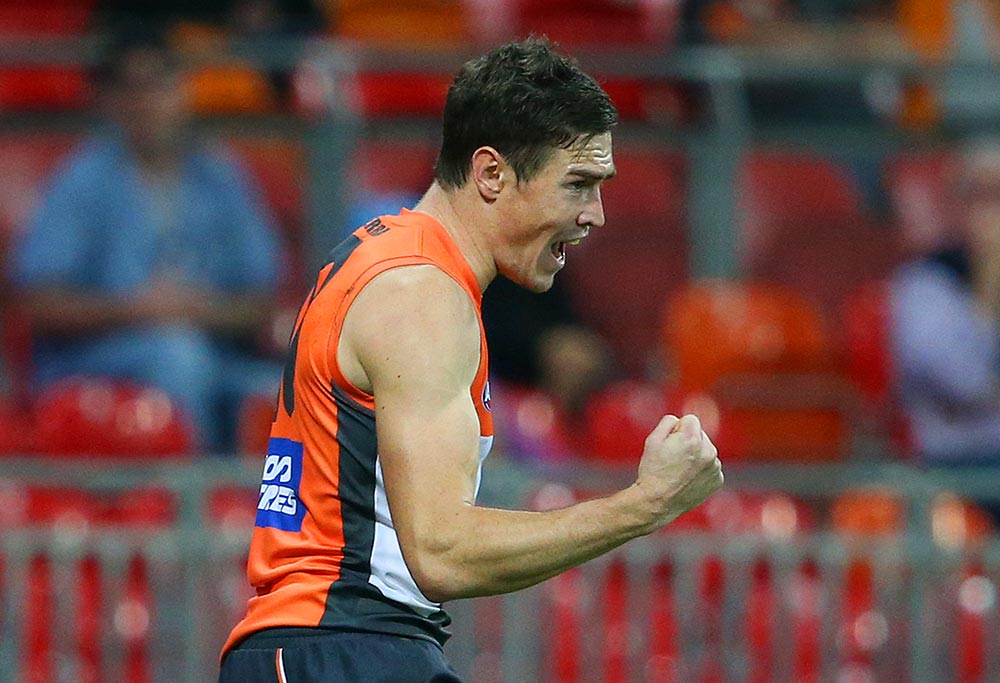
Missing some talent, but their youngsters have filled the void
What’s more, the Giants have been wrecked by injury and absence in the opening part of the season. Lachie Whitfield is serving a six-month illicit drugs code-related violation which has another three rounds to run. Newly traded Brett Deledio is yet to make his Giants debut, and according to reports from over the weekend remains a few weeks away from action.
Stephen Coniglio injured his ankle in the preseason and also remains a few weeks away from action. Matt Buntine played two games before it emerged he had been carrying an ACL injury for two years. Those are four best 22 players (Buntine would have been in competition with Haynes, Corr and Tomlinson for the medium-tall defender slot) who’ve played little to no football in 2017.
In their place, the Giants have unveiled some depth which many thought had been eroded by years of opposition raids. Journeyman Sam Reid, who had played 20 games in five years, including a two-year stretch with no senior football, has been a fixture of the Giants’ forward line.
Adam Kennedy, who was a staple of the early days, has played every game as a bottom-of-the-rotation midfielder.
Corr, who had looked to have fallen to the bottom of the defender pecking order, has been a very handy one-on-one stopper.
2016 draftee Matthew Kennedy has filled another spot in the rotation, while classmate Jacob Hopper has bullocked his way to a regular spot in the side going forward, probably taking the role of Ryan Griffen as a forward-of-centre oriented midfielder. The Giants’ first pick from last year’s draft, Tim Taranto, has played four games.
What’s notable in all of this is the relatively meagre possession totals of the fill-in talent. While the Kennedys and Taranto and Corr have played their roles, the top-end talent has been driving the Giants forward. With Whitfield, Deledio and Coniglio set to return for the second half of the season, it’s not just likely the Giants will get better as the season progresses. It’s guaranteed.
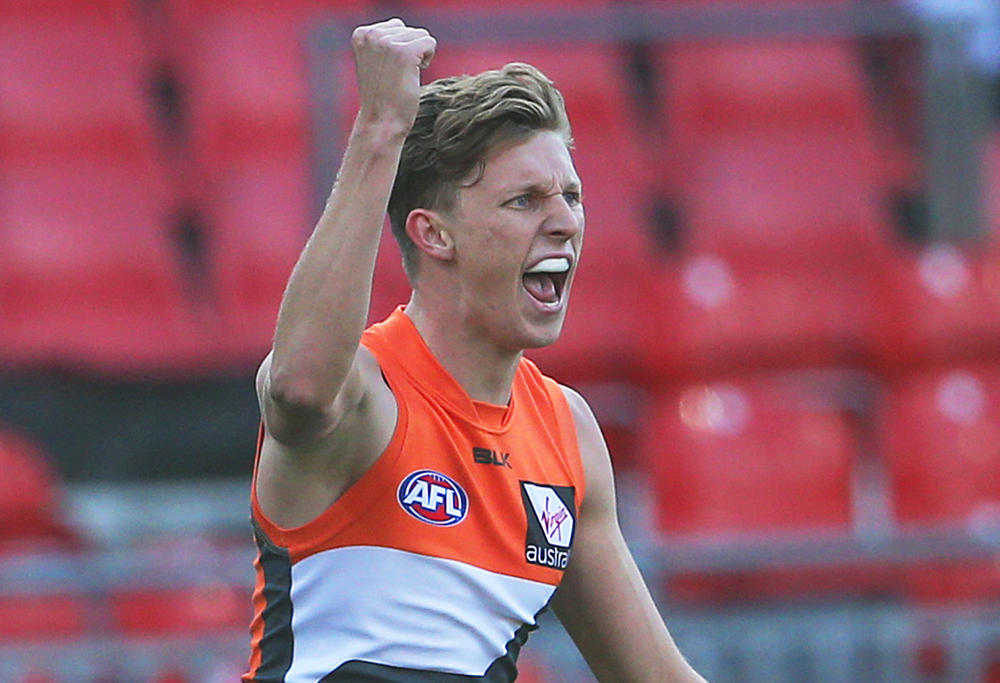
The Crowbots will save us
But Greater Western Sydney are vulnerable. The Crowbots of Adelaide, and to a lesser extent Port Adelaide in Round 4, were able to bust the precision machine of the Giants with old fashioned hard work.
Adelaide are the only team to have beaten the Giants in the ground game in 2016, winning the metric (which is contested possessions, less free kicks and contested marks) 116 to 96. The Crows were able to run the Giants off their feet, keeping the ball out of their opponent’s dangerous hands and off their daisy-cutting boots. As the game progressed, the margin grew, and Adelaide’s running machine proved too much for GWS to stop.
The two don’t play each other again in the home-and-away season, a cruel twist of fate thrust upon us by the vagaries of the AFL fixture. We can only hope there is at least one final eight permutation that will see them duel again.
Port Adelaide opted for an accountable system, as they have for most of the season to date. It was a gamble that looked like paying off until three-quarter time, when the Power started to tire and the Giants were able to prosecute their gradual wins around the ground and run away with the game.
GWS have an abundance of talent that is difficult for the best teams to match up on, and impossible for everyone else. Both the Crows and Power looked to make every Giant player accountable, and it is that which has made GWS look most vulnerable to date in 2017. It is a lesson that opposition coaches are undoubtedly going to take forward.
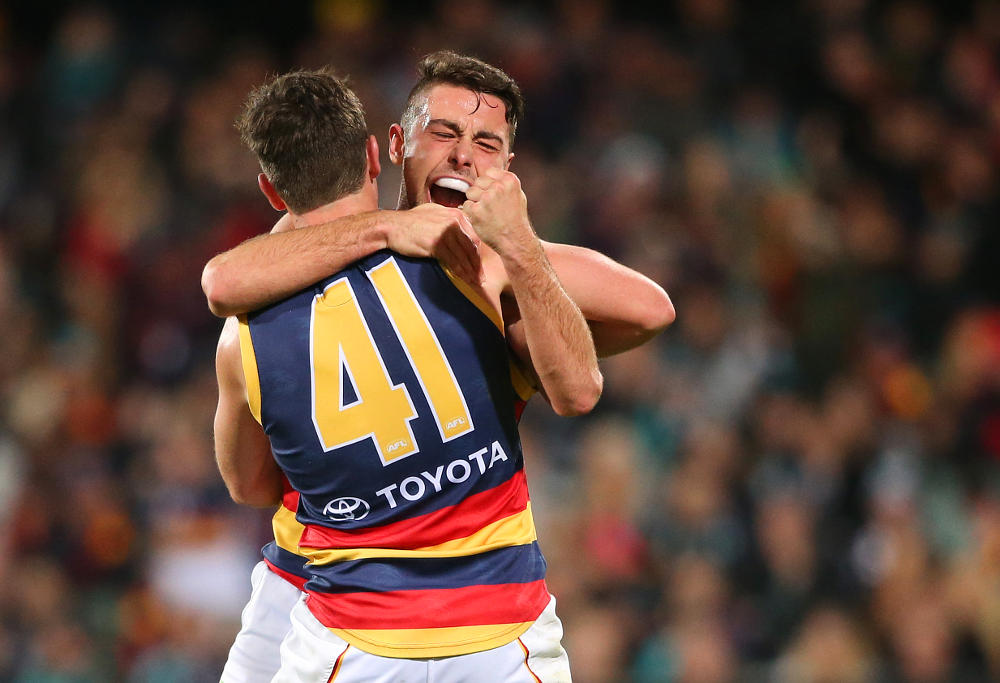
Making hay while the sun shines
The Giants have a tough schedule, but are arguably in a bit of a soft patch right now. They’re making the most of it, with a percentage of 180 in their past four games. That’ll come back down a touch in the weeks ahead, but it is a sign of the beatings they are handing out. Well might they, because things get tougher going forward.
We said it in the GWS season preview but it bears repeating in full. In 2017, Greater Western Sydney travel to play Adelaide, North Melbourne (Tasmania), Hawthorn (Tasmania), West Coast, Geelong at Geelong, St Kilda (Etihad) and the Western Bulldogs (away). To date they’ve conquered two of those mountains, but three to five remain, depending on how you rate the Saints and Hawks on their home decks.
Their home stands get tougher as the season goes on. After this weekend’s Canberra hit out, the Giants host Collingwood, Richmond and Essendon (with a trip to West Coast in between) in the lead-up to the halfway point of the season.
The Pies touched the Giants up last time around but I wouldn’t bank on a repeat performance. The Tigers are surging and this one already looks like a fun day out even though it’s a few weeks away. Who knows what’ll be happening at Essendon by Round 11.
By then, GWS should have Whitfield, Coniglio and Deledio in their starting line-up. That’s when the season really begins. After potential 100-point wins against Carlton and Brisbane (with their bye in between), GWS play Geelong (H), Hawthorn (Tasmania), Sydney (H), Richmond (MCG), Fremantle (H), Melbourne (Canberra), the Western Bulldogs (Etihad), West Coast (H) and Geelong (Geelong) to round out the year. It’s a remarkably tough looking run home, and one that will have GWS primed for September action.
In the mean time, there’s a strong chance the Giants hit their Round 15 meeting with the Cats with just one blemish in their loss column, and with a host of key players just hitting their straps.
For the rest of the competition, and the AFL diaspora at large, there have been enough interesting stories and angles to cover without having to delve into the murky depth of the expansion waves. That won’t last much longer. The Team That Shall Not Be Named are doing exactly what we thought they would do, and remarkably with one hand tied behind their back.
This isn’t a fairy tale. This is the AFL in 2017. The Giants are here, to stomp all over your dreams. You just don’t know it yet.





























































































